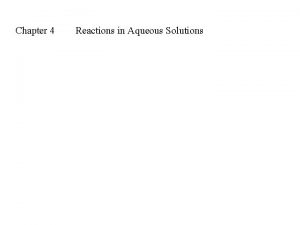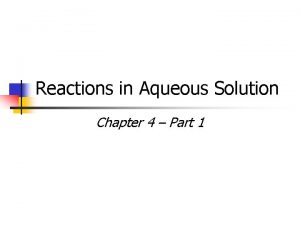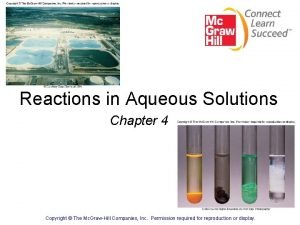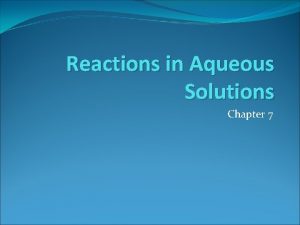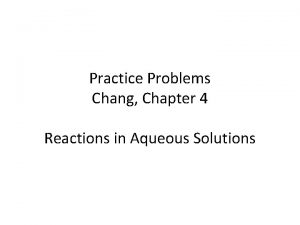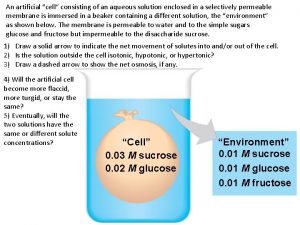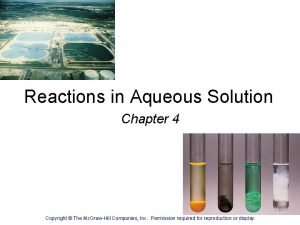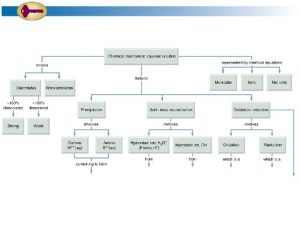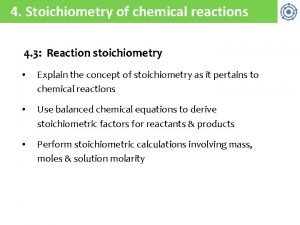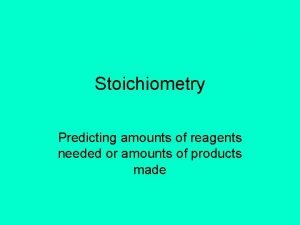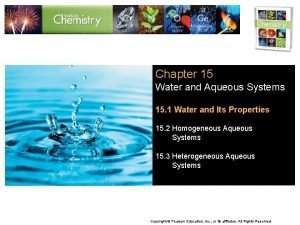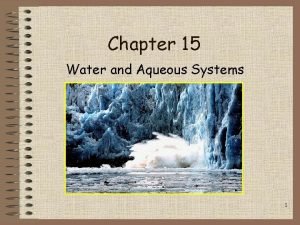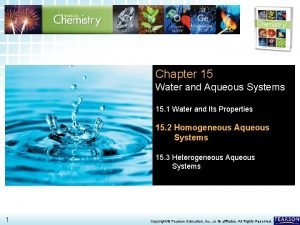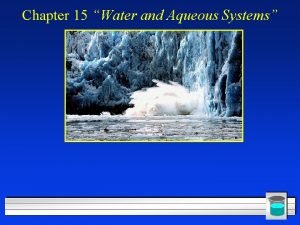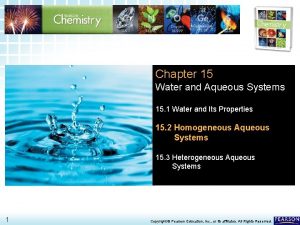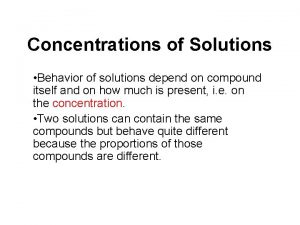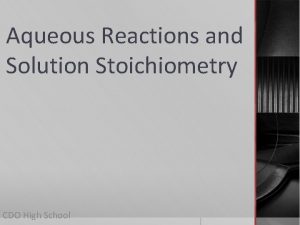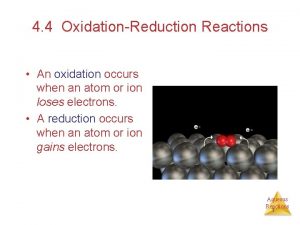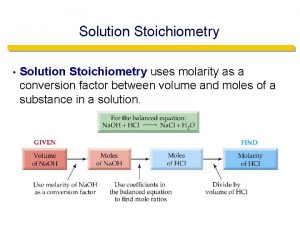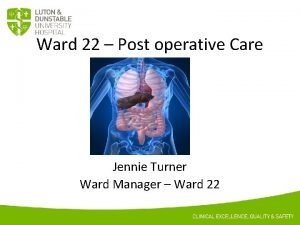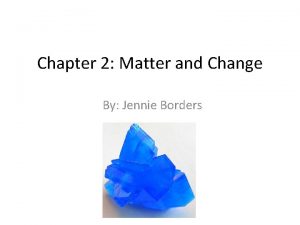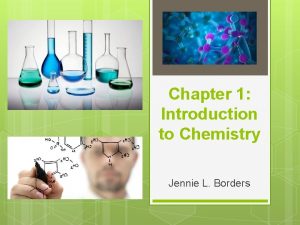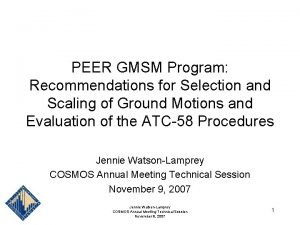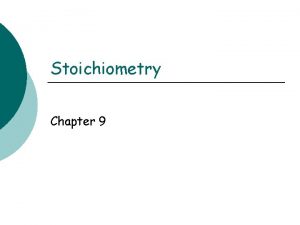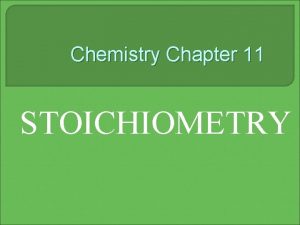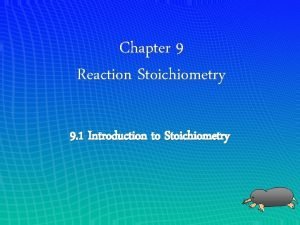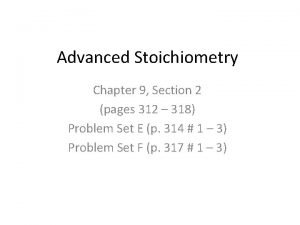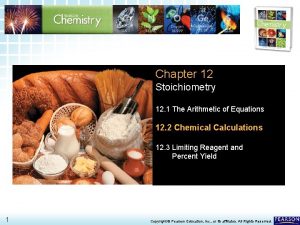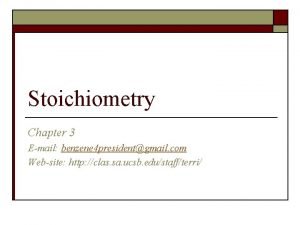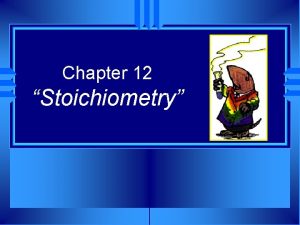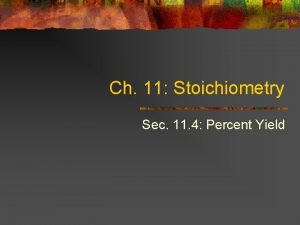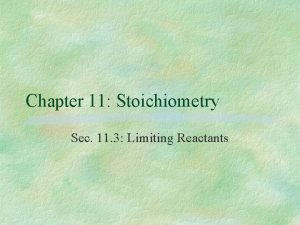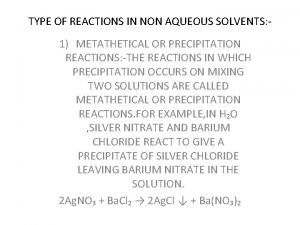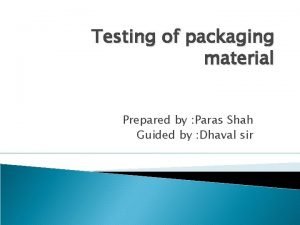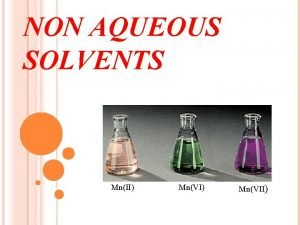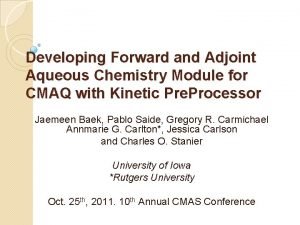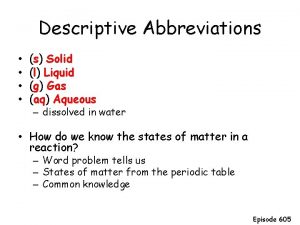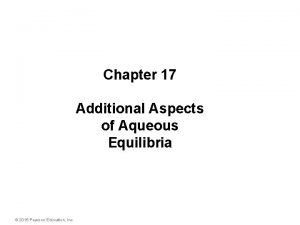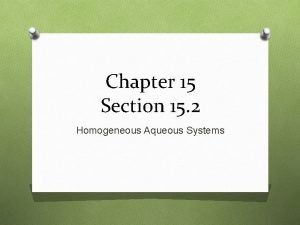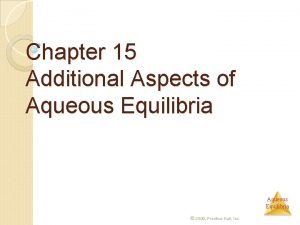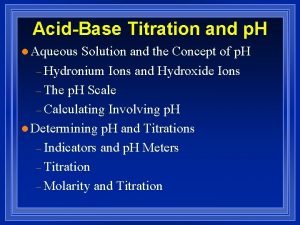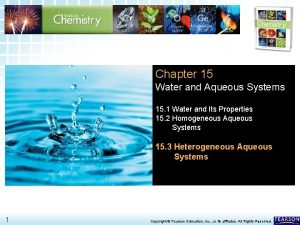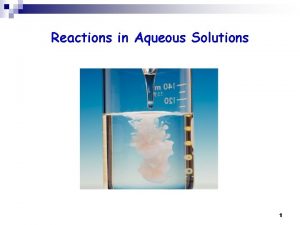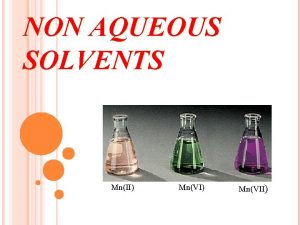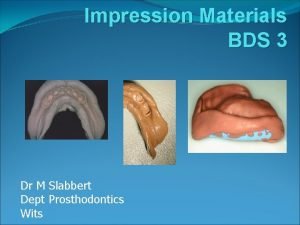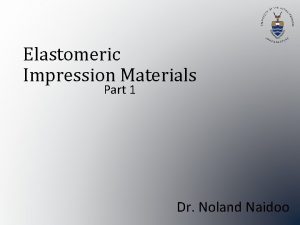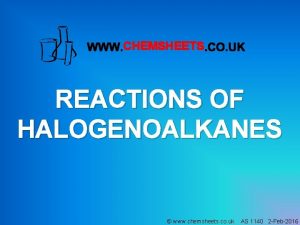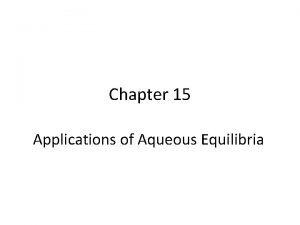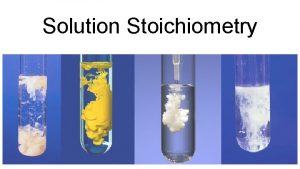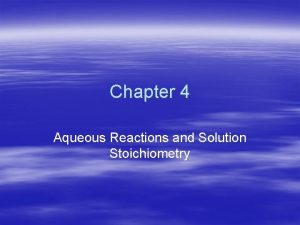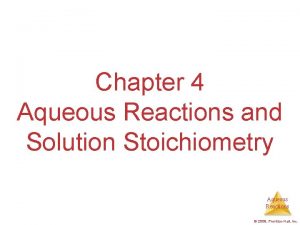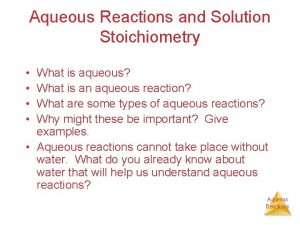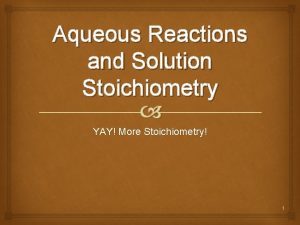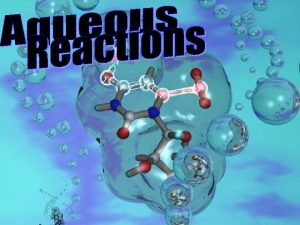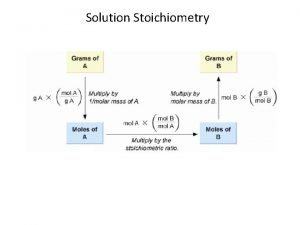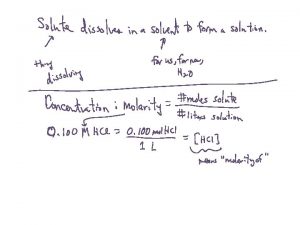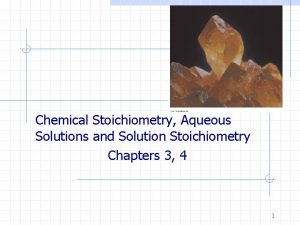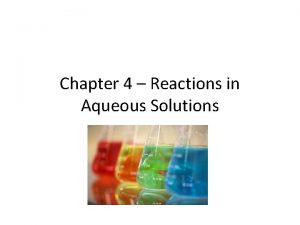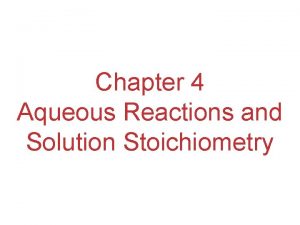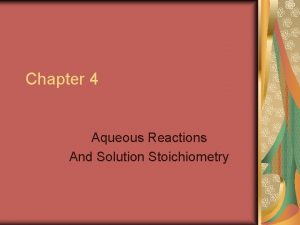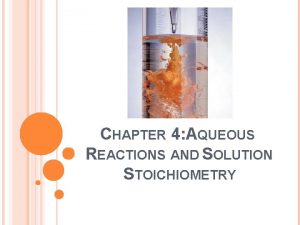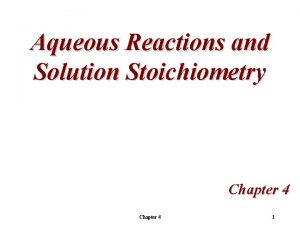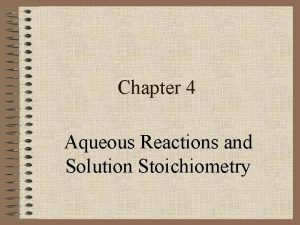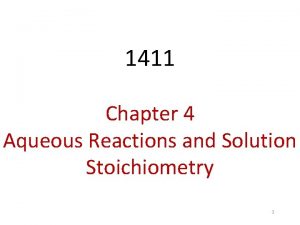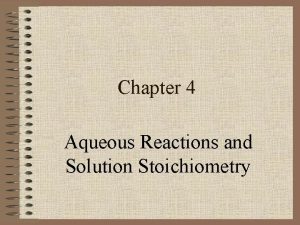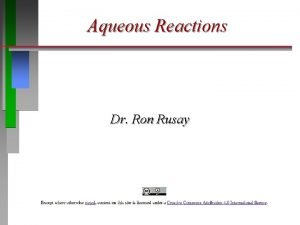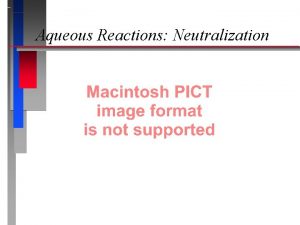CHAPTER 4 AQUEOUS REACTIONS AND SOLUTION STOICHIOMETRY Jennie















































































- Slides: 79

CHAPTER 4: AQUEOUS REACTIONS AND SOLUTION STOICHIOMETRY Jennie L. Borders

SECTION 4. 1 –GENERAL PROPERTIES OF AQUEOUS SOLUTIONS A solution is a homogeneous mixture of two or more substances. A solution in which water is the dissolving medium is called an aqueous solution.

SOLUTE VS. SOLVENT The substance present in the greatest quantity is called the solvent. Water is considered the universal solvent because of its ability to dissolve many substances. The other dissolved substances are called the solutes. A solvent dissolves a solute.

ELECTROLYTES A substance whose aqueous solutions contain ions is called an electrolyte because it will allow electric current to flow through it. Ex. Na. Cl A substance that does not form ions in solution is called a nonelectrolyte. Ex. C 12 H 22 O 11

IONIC COMPOUNDS IN WATER When ionic compounds dissolve in water the ions separate and are surrounded by water molecules. Once the ions have separated, they can move and conduct electricity. In the crystalline form they cannot move or conduct electricity. The solvation process helps stabilize the ions in solution and prevents the cations and anions from recombining.

IONIC COMPOUND IN WATER Water molecules are polar and have a d+ and dside. The more electronegative oxygen atoms are attracted to the positive ions. The less electronegative hydrogen atoms are attracted to the negative ions.

MOLECULAR COMPOUNDS IN WATER When a molecular compound dissolves in water, the solution usually consists of intact molecules (neutral) dispersed throughout the system. Consequently, most molecular compounds are nonelectrolytes. A few exceptions include strong acids like HCl. Ionic vs. Molecular

STRONG AND WEAK ELECTROLYTES Strong electrolytes are those solutes that exist in solution completely or nearly completely as ions. Weak electrolytes are those solutes that exist in solution mostly in the form of molecules with only a small fraction in the form of ions.

CHEMICAL EQUILIBRIUM Chemical equilibrium is the state of balance in which the relative numbers of each type of ion or molecule in the reaction are constant over time. Equilibrium is represented by a double arrow for the yield sign. This shows that the reaction is occurring in both directions.

STRONG ELECTROLYTES Remember that soluble ionic compounds are strong electrolytes. We consider ionic compounds as those composed of metals and nonmetals – such as Na. Cl, Fe. SO 4 and Al(NO 3)3 – or compounds containing the ammonium ions, NH 4+ - such as NH 4 Br and (NH 4)2 CO 3.

SAMPLE EXERCISE 4. 1 The diagram below represents an aqueous solution of one of the following compounds: Mg. Cl 2, KCl, or K 2 SO 4. Which solution does the drawing best represent?

PRACTICE EXERCISE If you were to draw diagrams like the previous one representing aqueous solutions of each of the following ionic compounds, how many anions would you show if the diagram contained six cations? a. Ni. SO 4 b. Ca(NO 3)2 c. Na 3 PO 4 d. Al 2(SO 4)3

SECTION 4. 2 –PRECIPITATION REACTIONS Reactions that result in the formation of an insoluble product are called precipitate reactions. A precipitate is an insoluble solid formed by a reaction in solution.

SOLUBILITY The solubility of a substance at a given temperature is the amount of substance that can be dissolved in a given quantity of solvent at a given temperature. Most important solubility rule: Alkali metal ions and ammonium ions are soluble in water.

SAMPLE EXERCISE 4. 2 Classify the following ionic compounds as soluble or insoluble in water: a. Sodium carbonate b. Lead (II) sulfate

PRACTICE EXERCISE Classify the following compounds as soluble or insoluble in water: a. Cobalt (II) hydroxide b. Barium nitrate c. Ammonium phosphate

EXCHANGE REACTIONS Reactions in which positive ions and negative ions appear to exchange partners conform to the following generic equation: AX + BY AY + BX Such reactions are called exchange reactions, double displacement reactions, or metathesis reactions.

STEPS FOR WRITING DOUBLE DISPLACEMENT REACTIONS 1. 2. 3. 4. Write the formulas for the reactants (balance charges). Write the formulas for the products by switching the cations of the two reactants (balance charges). Balance the equation. Include states of matter when needed.

SAMPLE EXERCISE 4. 3 a. Predict the identity of the precipitate that forms when solutions of Ba. Cl 2 and K 2 SO 4 are mixed. b. Write the balanced chemical equation for the reaction.

PRACTICE EXERCISE a. What compound precipitates when solutions of Fe 2(SO 4)3 and Li. OH are mixed? b. Write a balanced equation for the reaction. c. Will a precipitate form when solutions of Ba(NO 3)2 and KOH are mixed?

COMPLETE IONIC EQUATIONS o o A molecular equation is an equation showing the complete chemical formulas of the reactants and products without showing dissociated ions. Ex: Pb(NO 3)2(aq) + 2 KI(aq) Pb. I 2(s) + 2 KNO 3(aq) A complete ionic equations is an equation that shows all soluble strong electrolytes as ions. o Ex: Pb 2+(aq) + 2 NO 3 -(aq) + 2 K+(aq) + 2 I-(aq) Pb. I 2(s) + 2 K+(aq) + 2 NO 3 -(aq) o

NET IONIC EQUATIONS Ions that appear in identical forms on both sides of the yield sign are called spectator ions because they do not actually react. A net ionic equation is an equation in which the spectator ions have been removed. Complete Ionic Equation Pb 2+(aq) + 2 NO 3 -(aq) + 2 K+(aq) + 2 I-(aq) Pb. I 2(s) + 2 K+(aq) + 2 NO 3 -(aq) Net Ionic Equation Pb 2+(aq) + 2 I-(aq) Pb. I 2(s)

NET IONIC EQUATIONS In a net ionic equation, the numbers of atoms and the charges are conserved in the reaction. If every ion in a complete ionic equation is a spectator, then no reaction occurs.

STEPS FOR WRITING NET IONIC EQUATIONS 1. 2. 3. Write the balanced equation. Write the complete ionic equation which shows strong electrolytes (ionic compounds and strong acids) written as ions. Identify and cancel spectator ions.

SAMPLE EXERCISE 4. 4 Write the net ionic equation for the precipitation reaction that occurs when solutions of calcium chloride and sodium carbonate are mixed.

PRACTICE EXERCISE Write the net ionic equation for the precipitation reaction that occurs when aqueous solutions of silver (I) nitrate and potassium phosphate are mixed.

SECTION 4. 3: ACID-BASE REACTIONS Acids and bases are also common electrolytes. Acids are substances that ionize in aqueous solutions to form hydrogen ions. Since hydrogen ions consist of only 1 proton, acids are often called proton donors.

Acids Monoprotic acids contain one ionizable hydrogen. Ex: HCl Diprotic acids contain two ionizable hydrogens. Ex: H 2 SO 4 Triprotic acids contain three ionizable hydrogens. Ex: H 3 PO 4 Most multiprotic acids only lose one hydrogen to a reasonable extent.

Acids taste sour. Some acids also contain hydrogens that will not ionize. Normally the hydrogen(s) that will ionize are listed at the from of the chemical formula. Ex: HC 2 H 3 O 2 Sometimes the hydrogen that will ionize is listed at the end of a COOH group. Ex: CH 3 COOH

Bases taste bitter. Bases are substances that accept (react with ) hydrogen ions. Bases produce hydroxide ions (OH-) when they dissolve in water. Bases do not have to contain the hydroxide ion. Ex. Na. OH vs. NH 3

Strong vs. Weak Strong acids and bases are strong electrolytes so they fully ionize in solution. Weak acids and bases are weak electrolytes so they only partially ionize in solution.

Strong Acids You need to memorize the strong acids. HCl HBr HI HCl. O 3 HCl. O 4 HNO 3 H 2 SO 4 hydrochloric acid hydrobromic acid hydroiodic acid chloric acid perchloric acid nitric acid sulfuric acid

STRONG BASES You need to memorize the strong bases. Group 1 metal hydroxides: Li. OH, Na. OH, KOH, Rb. OH, and Cs. OH Heavy Group 2 metal hydroxides: Ca(OH)2, Sr(OH)2, and Ba(OH)2

SAMPLE EXERCISE 4. 5 The following diagrams represent aqueous solutions of three acids (HX, HY, and HZ) with water molecules omitted for clarity. Rank them from strongest to weakest.

PRACTICE EXERCISE Imagine a diagram showing 10 Na+ ions and 10 OHions. If this solution were mixed with the one pictured on the previous question for HY, what would the diagram look like that represents the solution after any possible reaction? (H+ ions will reaction with OH- ions to form H 2 O. )

STRONG VS. WEAK ELECTROLYTE Strong Electrolyte Weak Electrolyte Non-electrolyte Ionic All None Molecular Strong Acids Weak acids and weak bases All other compounds

SAMPLE EXERCISE 4. 6 Classify the following substances as a strong electrolyte, weak electrolyte, or nonelectrolyte: Ca. Cl 2, HNO 3, C 2 H 5 OH (ethanol), HCOOH (formic acid), KOH.

PRACTICE EXERCISE Consider solutions in which 0. 1 mol of each of the following compounds is dissolved in 1 L of water: Ca(NO 3)2, C 6 H 12 O 6 (glucose), CH 3 COONa (sodium acetate), and CH 3 COOH (acetic acid). Rank the solutions in order of increasing electrical conductivity based on the fact that the greater the number of ions in solution the greater the conductivity.

NEUTRALIZATION REACTIONS When a solution of an acid and a solution of a base are mixed, a neutralization reaction occurs. The products of the reaction are water and a salt. A salt is any ionic compound whose cation comes from a base and whose anion comes from an acid.

SAMPLE EXERCISE 4. 7 a. Write a balanced equation for the reaction between aqueous solutions of acetic acid (CH 3 COOH) and barium hydroxide. b. Write the net ionic equation for this reaction.

PRACTICE EXERCISE a. Write a balanced equation for the reaction of carbonic acid (H 2 CO 3) and potassium hydroxide. b. Write the net ionic equation for this reaction.

GAS FORMATION The sulfide ion and the carbonate ion will react with acids to form gases. Ex: S 22 HCl(aq) + Na 2 S(aq) H 2 S(g) + 2 Na. Cl(aq) Ex: CO 32 HCl(aq) + Na. HCO 3(aq) Na. Cl(aq) + H 2 CO 3(aq) H 2 O(l) + CO 2(g) So … HCl(aq) + Na. HCO 3(aq) Na. Cl(aq) + H 2 O(l) + CO 2(g)

SECTION 4. 4 –OXIDATION-REDUCTION REACTIONS Oxidation-reduction reactions (redox reactions) are reactions in which electrons are transferred between reactants. Oxidation is loss of electrons. Reduction is gain of electrons. Oxidation and reduction always occur together.

RULES FOR OXIDATION NUMBERS 1. 2. 3. For an atom in its elemental form, the oxidation number is always zero. Ex: Na = 0 F 2 = 0 For any monatomic ion the oxidation number equals the charge on the ion. Ex: Mg 2 N 3 – Mg = +2, N = -3 The oxidation number of hydrogen is usually +1 when bonded to nonmetals and -1 when bonded to metals Ex: HCl H = +1 Li. H H = -1

RULES FOR OXIDATION NUMBERS 4. 5. The oxidation number of oxygen is usually -2 (except in peroxide, O 22 -, where it is -1). Ex: CO 2 O = -2 H 2 O 2 O = -1 The oxidation number of fluorine is -1 in all compounds. The other halogens have an oxidation number of -1 except when combined with oxygen in oxyanions. Ex: Na. F HBr Cl. O- F = -1 Br = -1 Cl = +1

RULES FOR OXIDATION NUMBERS 6. The sum of the oxidation numbers of all atoms in a neutral compound is zero. The sum of the oxidation numbers in a polyatomic ion equals the charge of the ion. Ex: P 2 O 5 O = -2, so P = +5 CO 32 O = -2, so C = +4

SAMPLE EXERCISE 4. 8 Determine the oxidation number of sulfur in each of the following: a. H 2 S b. S 8 c. SCl 2 d. Na 2 SO 3 e. SO 42 -

PRACTICE EXERCISE What is the oxidation state of each element in the following: a. P 2 O 5 b. Na. H c. Cr 2 O 72 d. Sn. Br 4 e. Ba. O 2

OXIDATION OF METALS Many metals undergo displacement reactions with acids to form salts and hydrogen gas. Mg(s) + 2 HCl(aq) Mg. Cl 2(aq) + H 2(g) 0 +1 -1 +2 -1 0 Write the oxidation numbers for each element to determine which element is oxidized and which is reduced. Since Mg goes from 0 to +2, it is oxidized. Since H goes from +1 to 0, it is reduced.

SAMPLE EXERCISE 4. 9 Write the balance equation and net ionic equation for the reaction of aluminum with hydrobromic acid.

PRACTICE EXERCISE a. Write a balanced equation and net ionic equation for the reaction between magnesium and cobalt (II) sulfate. b. What is oxidized and what is reduced in the reaction?

THE ACTIVITY SERIES A list of metals arranged in order of decreasing ease of oxidation is called an activity series. Active metals are at the top of the series and are most easily oxidized. Noble metals are at the bottom of the series are not very reactive. Any metal on the list can be oxidized by the ions of elements below it.

ACTIVITY SERIES

SAMPLE EXERCISE 4. 10 Will an aqueous solution of iron (II) chloride oxidize magnesium metal? If so, write the balanced equation and net ionic equation for the reaction.

PRACTICE EXERCISE Which of the following metals will be oxidized by Pb(NO 3)2: Zn, Cu, Fe?

SECTION 4. 5 –CONCENTRATIONS OF SOLUTIONS Scientists use the term concentration to designate the amount of solute dissolved in a given quantity of solvent or solution. Molarity (M) expresses the concentration of a solution as the number of moles of solute in a liter of solution. Molarity = moles of solute liters of solution

SAMPLE EXERCISE 4. 11 Calculate the molarity of a solution made by dissolving 23. 4 g of sodium sulfate in enough water to form 125 m. L of solution.

PRACTICE EXERCISE Calculate the molarity of a solution made by dissolving 5. 00 g of glucose in sufficient water to form exactly 100 m. L of solution.

IONIC COMPOUNDS When calculating concentration, remember that ionic compounds break into ions in solutions. Ex: Mg. Cl 2 breaks into Mg 2+ and 2 Cl

SAMPLE EXERCISE 4. 12 What are the molar concentrations of each of the ions present in a 0. 025 M aqueous solution of calcium nitrate?

PRACTICE EXERCISE What is the molar concentration of K+ ions in a 0. 015 M solution of potassium carbonate?

MOLARITY Since molarity equals mol/L, it can be used as a conversion factor.

SAMPLE EXERCISE 4. 13 How many grams of Na 2 SO 4 are required to make 0. 350 L of 0. 500 M Na 2 SO 4?

PRACTICE EXERCISE a. How many grams of Na 2 SO 4 are there in 15 m. L of 0. 50 M Na 2 SO 4? b. How many milliliters of 0. 50 M Na 2 SO 4 solution are needed to provide 0. 038 mol of this salt?

DILUTION Stock solutions are solutions that are purchased at a specific concentration, but sometimes a different concentration is needed for an experiment. Solutions of lower concentration can then be obtained by adding water, a process called dilution. When solvent is added to dilute a solution, the number of moles of solute remains the same. M 1 x V 1 = M 2 x V 2

SAMPLE EXERCISE 4. 14 How many milliliters of 3. 0 M H 2 SO 4 are needed to make 450 m. L of 0. 10 M H 2 SO 4?

PRACTICE EXERCISE a. What volume of 2. 50 M lead (II) nitrate solution contains 0. 0500 mol of Pb 2+? b. How many milliliters of 5. 0 M K 2 Cr 2 O 7 solution must be diluted to prepare 250 m. L of 0. 10 M solution? c. If 10. 0 m. L of a 10. 0 M stock solution of Na. OH is diluted to 250 m. L, what is the concentration of the resulting stock solution?

SECTION 4. 6 –SOLUTION STOICHIOMETRY AND CHEMICAL ANALYSIS You can use molar mass and molarity to solve stoichiometry problems.

SAMPLE EXERCISE 4. 15 How many grams of Ca(OH)2 are needed to neutralize 25. 0 m. L of 0. 100 M HNO 3?

PRACTICE EXERCISE a. How many grams of Na. OH are needed to neutralize 20. 0 m. L of 0. 150 M H 2 SO 4 solution? b. How many liters of 0. 500 M HCl are needed to react completely with 0. 100 mol of Pb(NO 3)2, forming a precipitate of Pb. Cl 2?

TITRATIONS To determine the concentration of a particular solute in a solution, chemists often carry out a titration, which involves combining a sample of the solution with a reagent solution of known concentration, called a standard solution.

TITRATIONS The point at which stoichiometrically equivalent quantities are brought together is known as the equivalence point. In acid-base titrations, dyes known as acid-base indicators are used to identify the equivalence point. The color change of the indicator signals the end point of the titration, which usually coincides very nearly with the equivalence point.

SAMPLE EXERCISE 4. 16 a. How many grams of chloride ion are in a sample of the water if 20. 2 m. L of 0. 100 M Ag+ is needed to react with all the chloride in the sample? Ag+(aq) + Cl-(aq) Ag. Cl(s) a. If the sample has a mass of 10. 0 g, what percent Cl- does it contain?

PRACTICE EXERCISE A solution that contains Fe 2+ is titrated with 47. 20 m. L of 0. 02240 M Mn. O 4 -. How many moles of Mn. O 4 - were added to the solution? Mn. O 4 -(aq) + 5 Fe 2+(aq) + 8 H+(aq) Mn 2+(aq) + 5 Fe 3+(aq) + 4 H 2 O(l) a. b. How many moles of Fe 2+ were in the sample?

PRACTICE EXERCISE c. How many grams of iron were in the sample? d. If the sample had a mass of 0. 8890 g, what is the percentage of iron in the sample?

SAMPLE EXERCISE 4. 17 One commercial method used to peel potatoes is to soak them in a solution of Na. OH for a short time, remove them from the Na. OH, and spray off the peel. The concentration of Na. OH is normally in the range of 3 to 6 M. The Na. OH is analyzed periodically. In one such analysis, 45. 7 m. L of 0. 500 M H 2 SO 4 is required to neutralize a 20. 0 m. L sample of Na. OH solution. What is the concentration of the Na. OH solution?

PRACTICE EXERCISE What is the molarity of an Na. OH solution if 48. 0 m. L is needed to neutralize 35. 0 m. L of 0. 144 M H 2 SO 4?

SAMPLE INTEGRATIVE EXERCISE A sample of 70. 5 mg of potassium phosphate is added to 15. 0 m. L of 0. 050 M silver nitrate, resulting in the formation of a precipitate. a. Write the molecular equation for the reaction. b. What is the limiting reagent in the reaction?

SAMPLE INTEGRATIVE EXERCISE c. Calculate theoretical yield, in grams, of the precipitate that forms.
 Aqueous reactions and solution stoichiometry
Aqueous reactions and solution stoichiometry Chemical reactions section 3 reactions in aqueous solutions
Chemical reactions section 3 reactions in aqueous solutions Types of chemical reactions and solution stoichiometry
Types of chemical reactions and solution stoichiometry Types of chemical reactions and solution stoichiometry
Types of chemical reactions and solution stoichiometry Chapter 4 reactions in aqueous solutions
Chapter 4 reactions in aqueous solutions Concentrated solution
Concentrated solution Chapter 4 reactions in aqueous solutions worksheet answers
Chapter 4 reactions in aqueous solutions worksheet answers Chapter 4 reactions in aqueous solutions
Chapter 4 reactions in aqueous solutions Reactions in aqueous solutions
Reactions in aqueous solutions Aqueous solution
Aqueous solution An artificial cell consisting of an aqueous solution
An artificial cell consisting of an aqueous solution What is aqueous
What is aqueous The monophasic liquid can be given for
The monophasic liquid can be given for Assume that an aqueous solution of a cation
Assume that an aqueous solution of a cation Stoichiometry map for chemical reactions
Stoichiometry map for chemical reactions How to determine if a single replacement reaction occurs
How to determine if a single replacement reaction occurs Chemical reactions section 2 classifying chemical reactions
Chemical reactions section 2 classifying chemical reactions How to write half reactions
How to write half reactions Chemical reactions section 2 classifying chemical reactions
Chemical reactions section 2 classifying chemical reactions Chemistry unit 5 reactions balancing reactions worksheet
Chemistry unit 5 reactions balancing reactions worksheet Tyndall effect
Tyndall effect Chapter 15 water and aqueous systems
Chapter 15 water and aqueous systems Chapter 15 water and aqueous systems
Chapter 15 water and aqueous systems Chapter 15 water and aqueous systems
Chapter 15 water and aqueous systems Chapter 15 water and aqueous systems
Chapter 15 water and aqueous systems Solution stoichiometry
Solution stoichiometry Solution stoichiometry
Solution stoichiometry Solution stoichiometry
Solution stoichiometry Solution stoichiometry
Solution stoichiometry Jennie turner
Jennie turner Jennie finch pitching video
Jennie finch pitching video Jennie reid elementary
Jennie reid elementary Jennie ellis australia immigration
Jennie ellis australia immigration Jennie reeves radiographers agency
Jennie reeves radiographers agency Jennie borders chemistry
Jennie borders chemistry Jennie borders chemistry
Jennie borders chemistry Brandi conner
Brandi conner Jennie nyde
Jennie nyde Jennie
Jennie Chapter 11 stoichiometry assessment answer key
Chapter 11 stoichiometry assessment answer key Balancing redox reactions in acidic solution
Balancing redox reactions in acidic solution Define concentration cells
Define concentration cells Chapter 13 ions in aqueous solutions
Chapter 13 ions in aqueous solutions Chapter 10 chapter assessment chemical reactions answers
Chapter 10 chapter assessment chemical reactions answers Chapter 9 chemical reactions
Chapter 9 chemical reactions Ideal solution and non ideal solution
Ideal solution and non ideal solution Freezing point chapter 13
Freezing point chapter 13 Chapter 8 review describing chemical reactions
Chapter 8 review describing chemical reactions Chapter 8 section 1 chemical equations and reactions
Chapter 8 section 1 chemical equations and reactions Chemical equations and reactions chapter 8 review
Chemical equations and reactions chapter 8 review Chemistry chapter 9 stoichiometry
Chemistry chapter 9 stoichiometry Modern chemistry chapter 9 stoichiometry
Modern chemistry chapter 9 stoichiometry Chapter 11 stoichiometry
Chapter 11 stoichiometry Chapter 9 stoichiometry test
Chapter 9 stoichiometry test Chapter 9 review stoichiometry section 1
Chapter 9 review stoichiometry section 1 The first step in most stoichiometry problems is to ____
The first step in most stoichiometry problems is to ____ Chapter 9 section 2 stoichiometry
Chapter 9 section 2 stoichiometry Chapter 12 stoichiometry answer key pearson
Chapter 12 stoichiometry answer key pearson Stoichiometry example
Stoichiometry example Chapter 3 stoichiometry answer key
Chapter 3 stoichiometry answer key Chapter 12 stoichiometry
Chapter 12 stoichiometry Define percent yield
Define percent yield Limiting reactant def
Limiting reactant def Types of reaction in non aqueous solvents
Types of reaction in non aqueous solvents Clarity of aqueous extract test
Clarity of aqueous extract test Contoh pelarut anorganik adalah
Contoh pelarut anorganik adalah Non aqueous solvents examples
Non aqueous solvents examples Aqueous solutions module
Aqueous solutions module Liquid short form
Liquid short form Additional aspects of aqueous equilibria
Additional aspects of aqueous equilibria Do pickles conduct electricity
Do pickles conduct electricity Additional aspects of aqueous equilibria
Additional aspects of aqueous equilibria Aqueous acid base titration
Aqueous acid base titration Suspension vs solution
Suspension vs solution Is water aqueous
Is water aqueous What are protonic and non protonic solvents
What are protonic and non protonic solvents Non eugenol impression paste
Non eugenol impression paste Non elastic impression materials
Non elastic impression materials Reactions of halogenoalkanes 2 chemsheets answers
Reactions of halogenoalkanes 2 chemsheets answers Aqueous equilibria
Aqueous equilibria




